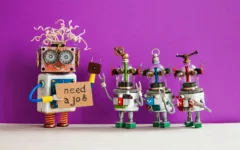Collaborative robots have only been around for about ten years now. For the early adopters who mainstreamed them early, they have seen and enjoyed the wonders that collaborative robots could bring to production on the factory floor.
Over the years, their knowledge and demand have increased over time. They are now produced by every major robot manufacturer while they only were a product of one creative forerunner manufacturing organization known as Universal Robots.
Collaborative robots are highly pragmatic and automate specific process of the assembly process. If there’s an aspect of the production that is slowing you down or leading to defective products, that is the aspect that you automate easily with collaborative robots.
Once this has been done, your production process changes completely leading to enhanced efficiency and effectiveness.
Why Collaborative robots?
1. Easy to use
When it comes to automating assembly, collaborative robots are easy to use. They are plug and play robots without much assembling and programming.
Assembling these robots after purchase takes up to one day for the longest process. After that you are free to use the robot in any part of the factory.
You can easily move it from one part of the factory to another and set it up at any position for as many tasks as possible.
They add convenience and flexibility to the robot assembly process ensuring increased productivity and quality of goods produced.
2. Affordability
The price tag on collaborative robots allows even the smallest of firms to afford automation and produce high quality products that enhance competition and provide variety and high quality products in the market.
In addition, they are such a good investment, they basically pay for themselves within a year. This has been shown to be true by the experience of the numerous factories already using collaborative robots and gearing up to increase those that they already have in their factories.
3. Do not require large spaces to operate
With collaborative robots, organizations will never again have to need large spaces to setup and keep their robots. With their compact size, collaborative robots use the minimum amount of space available. They are highly space and energy efficient thus help save large financial outlays and expenses.
4. Able to complete a different number of tasks
Collaborative robots are dynamic robots and as such can carry out a number of tasks in the factory. Their compactness also aids in these feature. Since they are easy to carry around, due to their small size and mobility accessories, they can be used in different processes at different ends of the factory.
This enhances the speed and accuracy with which different processes in the factory are carried out with.
The future of collaborative robots
1. Continued use
For all their unique features and benefits they offer production facilities, collaborative robots will suffer an increase in popularity and many more organizations will acquire them.
They will soon phase out the traditional robot as they gain additional capabilities without compromising on their nimbleness and flexibility.
With more players now coming into the collaborative robots field, they will help fuel the knowledge of collaborative robots and hence their increased presence in the factory floor.
2. Robot to robot collaboration
As the robots get more and more capabilities, certain tasks will be left completely to the robots as they collaborate among themselves in the production process.
This enables faster production of different components of the final product.
By having the human worker out of the production process of certain components, they are left to focus on more mentally stimulating challenges of design and aesthetics of the product being produced.
3. Increased capabilities
As it stands, collaborative robots have not scratched the surface of what they can offer within the factory. The future of collaborative robots looks ready to enhance them with complex features that will enable them to perform tasks that they have not yet started performing in the production process.








